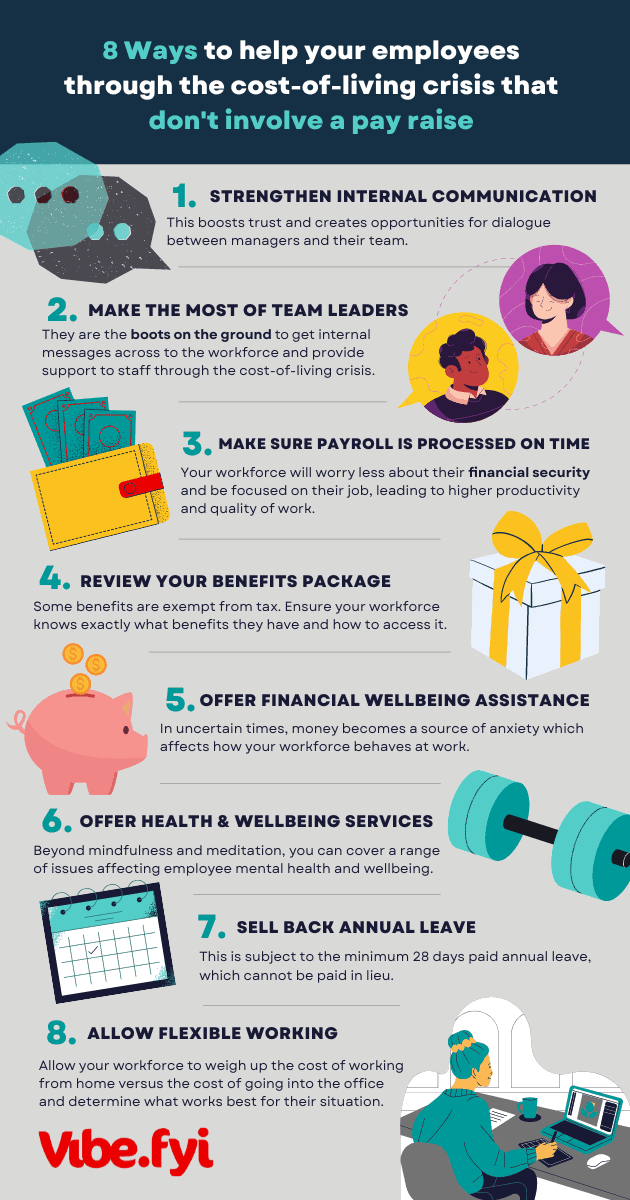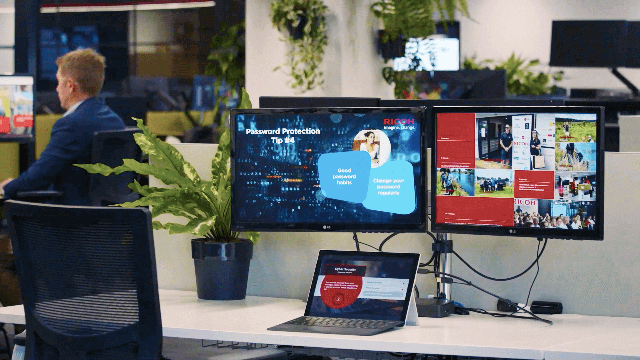Rising costs and inflation spell difficulty for the economic environment. Many employers are looking at how they can help with the rising
cost of living. We know that businesses aren't spared from these turbulent times either, so we've outlined eight
ways employers can help their employees
without giving them a pay rise.
What is causing the cost-of-living crisis?
The UK is facing a cost-of-living crisis, caused by a number of factors including the Covid-19 pandemic, rises in national insurance
contributions, political unrest in Eastern Europe and rising energy prices. Many household incomes have taken a hit – the biggest decline
since the 1970s. The Bank of England forecasted that inflation could hit up to 11% in the later half of 2022.
The impact on the business and its employees
Rising costs doesn’t impact all employees equally. For example, younger people tend to be on lower wages than older people; women are still more likely to be paid less than men; people with disabilities may need extra assistance.
For UK businesses, this means that they will have to manage unengaged and distracted employees, who are unhappy because of the state of their finances.
How do businesses support their employees?
Broadly speaking there are two ways of supporting employees: increase their pay or support them with their costs.
Some businesses are offering their salary increases that are in line with or above inflation. This raises employees’ wages in real terms.
While it might seem like a quick fix, increasing wages isn’t a viable option for businesses who can’t afford it. And it may not help all employees as it can impact their entitlement for tax deductions, universal credit, child benefit and more.

Share this image on your site. Copy and paste the embed code below:
8 ways to help your employees through the cost-of-living crisis that doesn’t involve a pay raise
1. Strengthen your internal communication
Compassion and understanding goes a long way. Strengthening your internal communications will boost trust and create opportunities for dialogue between managers and their team. When you build your communication strategy, here are some things you want to keep in mind:
- Be predictable. With so much change going on, you want to reduce disruption. Regular frequencies of communication showing up in the same channels show your team they can rely on you.
- Encourage feedback. Whether it’s using pulse surveys or one-on-one conversations, give your workforce the opportunity to ask questions, leave feedback and create conversation.
- Keep it short. It’s not just millennials and Gen Zs who want a short summary; everyone can benefit from bite-sized messages.

Internal communication messages that reach employees across multiple channels are more effective
2. Train managers and team leads
Aside from internal communicators, team leads and people managers play an important role in sharing the corporate narrative. They are the “boots on the ground” to get your message across to the workforce and provide support to staff through the cost-of-living crisis.
It’s easy for employees to tune out messages on the intranet or on social channels. It’s much harder to ignore a conversation with their manager or in team meetings. Plus, not every work environment allows staff to be always connected to a device – think frontline staff in the warehouse, distribution centre, aged care facilities and more.
3. Make sure payroll is processed on time
In turbulent economic times, financial security is on the line. That's why the timing and accuracy of payroll processing plays a key role in your workforce's wellbeing. Many employees rely on a stable paycheck and paying them late can have legal ramifications for the business. When your workforce knows their pay will be processed on time, they worry less about their financial security and are more focused on their job, leading to higher productivity and quality of work.
4. Review your benefits package
What does your benefits package include? Some ideas include:
- Free or subsidised meals for employees. This is covered by the staff canteen exemptions. Retailers like John Lewis, Waitrose and Sainsbury’s offer this.
- Staff welfare benefits. Offering things like free feminine hygiene products are covered by the trivial staff benefits exemption.
- Staff entertaining events. Reward your team with a day out; opt for events where you can settle the tax and NIC charge via the PAYE Settlement Agreement.
- Income tax-free cash allowances. If your employees are working from home and they meet the requirements for the Working from Home allowance, you can provide a cash allowance through their salary or they can claim tax relief from HMRC.
- Discounts at gyms and supermarkets
- On-site councillor or other employee assistance programs
In reviewing your benefits, make sure your workforce knows exactly what’s on offer and how to access it. You can post this information on your company intranet and in newsletters but one way to really get in front of employees is to promote your wellbeing benefits on digital signage screens. Digital screens reach everyone – even those who aren’t based on headquarters or in the office.

Feeding the workforce can boost job satisfaction, business productivity, and enhance teamwork
5. Offer financial wellbeing assistance
Mental health and money are connected. In uncertain times, money becomes a source of anxiety which affects how your workforce behaves at work. Financial wellbeing programs including financial literacy and education will empower employees to be confident when it comes to their personal finances.
Again, it’s not a one-size-fits-all approach when it comes to financial wellbeing. For instance, younger employees may deem pension contributions not essential and stop contributions. However, that has long-term implications that employers should communicate.
Review your financial wellbeing programs and promote it such that the workforce knows it’s a tool that’s available and they know how to access it. Some communication channels to consider include taking over their screensaver or web browser home page, and posting it on the intranet.
6. Offer health and wellbeing services
Beyond mindfulness and meditation, you can cover a range of issues affecting employee mental health and wellbeing.
To benefit as many employees as possible make sure your mental health programs are ready to access remotely. Since the pandemic, we’ve seen the rise of virtual health and wellbeing: online GP consultations, virtual fitness classes, virtual sessions with personal trainers, mental health professionals, nutritionists and more.
7. Sell back annual leave
Some businesses give the option for their employees to sell annual leave days. This is subject to the minimum 28 days paid annual leave, which cannot be paid in lieu.
This flexibility demonstrates that your organisation understands the current economic crisis and its impact on your workforce. It goes a long way in maintaining staff and enticing new talent.
8. Allow flexible working
According to the Office for National Statistics, the proportion of workers hybrid
working has risen slightly
during spring 2022.
Flexible working allows your workforce to weigh up the cost of working from home (e.g. internet, heating, electricity) versus the cost of going into the office (e.g. fuel, public transport, coffees) and determine what works best for their situation.
Conclusion
As cost of living and inflation rises in the UK, businesses have an obligation to look out for their workforce. Since not all businesses are in a financial position to give pay rises, we’ve shown you some creative and non-financial ways you can help your employees cope with rising costs. The goal for every initiative should be to increase employee wellbeing. That is the only way to retain your employees, attract talent and ride out these turbulent times together.



